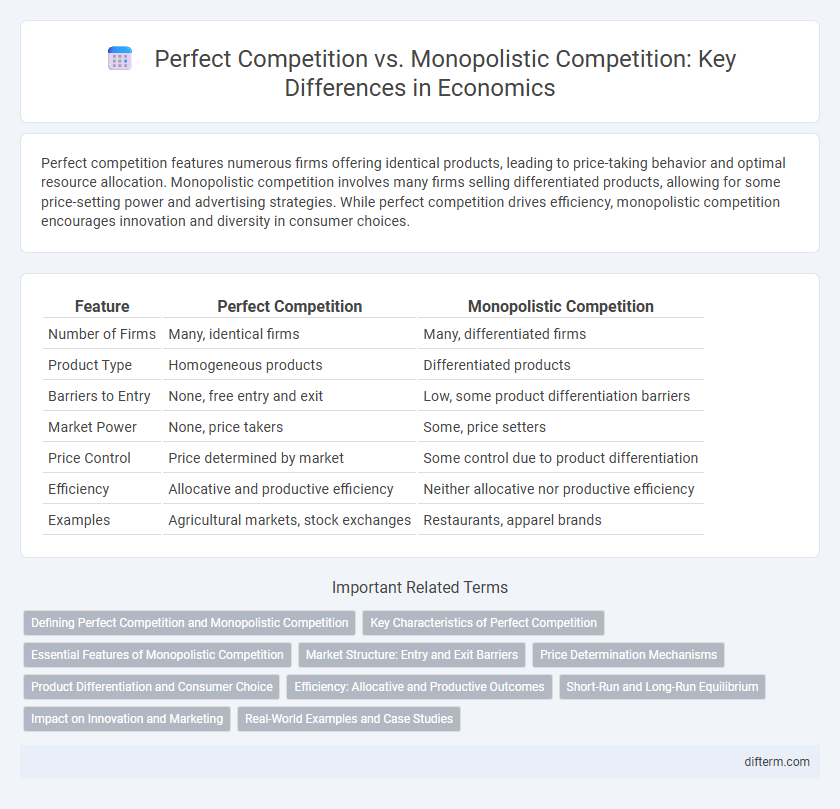Perfect competition features numerous firms offering identical products, leading to price-taking behavior and optimal resource allocation. Monopolistic competition involves many firms selling differentiated products, allowing for some price-setting power and advertising strategies. While perfect competition drives efficiency, monopolistic competition encourages innovation and diversity in consumer choices.
Table of Comparison
| Feature | Perfect Competition | Monopolistic Competition |
|---|---|---|
| Number of Firms | Many, identical firms | Many, differentiated firms |
| Product Type | Homogeneous products | Differentiated products |
| Barriers to Entry | None, free entry and exit | Low, some product differentiation barriers |
| Market Power | None, price takers | Some, price setters |
| Price Control | Price determined by market | Some control due to product differentiation |
| Efficiency | Allocative and productive efficiency | Neither allocative nor productive efficiency |
| Examples | Agricultural markets, stock exchanges | Restaurants, apparel brands |
Defining Perfect Competition and Monopolistic Competition
Perfect competition is defined by a market structure with numerous small firms selling identical products, where no single firm can influence the market price due to free entry and exit. Monopolistic competition features many firms offering differentiated products, allowing some control over pricing through brand loyalty and product variation. The key distinction lies in product homogeneity in perfect competition versus product differentiation in monopolistic competition.
Key Characteristics of Perfect Competition
Perfect competition features numerous small firms producing homogeneous products, ensuring no single firm can control market prices, which are determined solely by supply and demand. Firms face perfectly elastic demand curves, allowing for free entry and exit in the market, leading to zero economic profits in the long run. Price equals marginal cost, achieving allocative and productive efficiency, which distinguishes perfect competition from monopolistic competition.
Essential Features of Monopolistic Competition
Monopolistic competition is characterized by a large number of firms offering differentiated products, enabling each to have some price-setting power while still facing competition from close substitutes. Firms engage in non-price competition through advertising and product differentiation to attract customers. The ease of entry and exit in the market ensures that firms can enter when profits are high and leave when profits decline, maintaining a dynamic competitive environment.
Market Structure: Entry and Exit Barriers
Perfect competition features no barriers to entry or exit, allowing firms to freely enter or leave the market based on profitability, ensuring efficient resource allocation and zero economic profits in the long run. Monopolistic competition has low entry and exit barriers, enabling many firms to compete with differentiated products, but the presence of product differentiation creates some market power and slightly reduces efficiency. Entry barriers in monopolistic competition are minimal, but brand loyalty and advertising costs can impose indirect constraints on new market participants.
Price Determination Mechanisms
In perfect competition, price determination is dictated by market forces where numerous buyers and sellers ensure prices align with marginal cost, resulting in allocative efficiency. In contrast, monopolistic competition allows firms to influence prices through product differentiation, leading to a downward-sloping demand curve and prices above marginal cost. This price setting reflects a balance between competitive pressure and the unique attributes of each firm's products.
Product Differentiation and Consumer Choice
In perfect competition, products are homogeneous, eliminating product differentiation and limiting consumer choice to price-based decisions, whereas monopolistic competition features differentiated products that provide consumers with a variety of options based on features, branding, and quality. Product differentiation in monopolistic competition enhances consumer preference diversity, increasing market elasticity compared to the uniform offerings in perfect competition. This variation affects pricing strategies and consumer loyalty, with monopolistic markets allowing firms to exert more influence over prices due to unique product attributes.
Efficiency: Allocative and Productive Outcomes
Perfect competition achieves allocative efficiency as prices reflect marginal costs, ensuring resources are optimally distributed for maximum consumer satisfaction. Productive efficiency is realized since firms produce at the lowest point of their average total cost curve, minimizing costs in the long run. In contrast, monopolistic competition exhibits allocative inefficiency with prices exceeding marginal costs, and productive inefficiency as firms operate with excess capacity, leading to higher average costs.
Short-Run and Long-Run Equilibrium
In perfect competition, short-run equilibrium occurs where firms maximize profit by producing output where marginal cost equals marginal revenue, often resulting in economic profits or losses; in the long run, free entry and exit drive economic profits to zero, establishing a stable equilibrium with firms producing at minimum average total cost. Monopolistic competition features short-run equilibrium with firms earning profits due to product differentiation and some market power, but in the long run, new entrants erode these profits, pushing economic profit to zero and resulting in excess capacity where firms do not produce at minimum average total cost. The distinct dynamics in both market structures highlight differences in efficiency and firm behavior across the short and long run.
Impact on Innovation and Marketing
Perfect competition limits innovation due to homogeneous products and minimal profit margins, reducing firms' incentives to invest in research and development. Monopolistic competition fosters innovation by encouraging product differentiation and active marketing strategies, enabling firms to capture customer loyalty and justify higher prices. Marketing efforts in monopolistic competition enhance brand identity and consumer awareness, driving continuous improvements and diverse offerings in the market.
Real-World Examples and Case Studies
Perfect competition is exemplified by agricultural markets such as wheat and corn, where numerous small farmers sell homogeneous products with minimal price control. Monopolistic competition is demonstrated by the restaurant industry, where many businesses offer differentiated menus and ambiance, allowing for some pricing power and customer loyalty. Case studies of tech startups show how product differentiation and innovation create competitive advantages distinct from pure price competition in perfectly competitive markets.
perfect competition vs monopolistic competition Infographic

 difterm.com
difterm.com